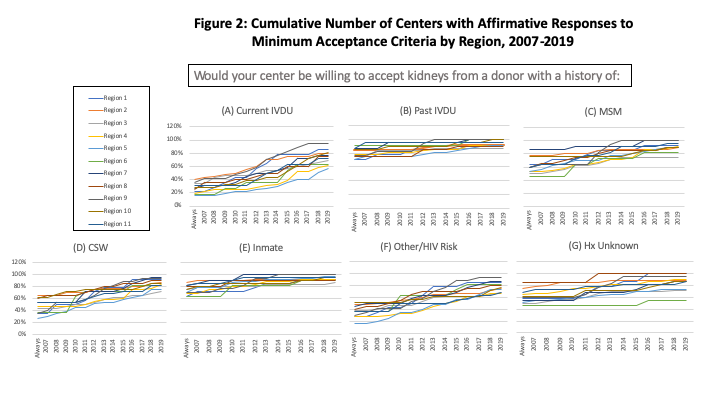Trends in Transplant Center Responses to the Minimum Acceptance Criteria Across UNOS Regions, 2007-2019
1Harvard Medical School, Boston, MA, 2Transplant Center, Massachusetts General Hospital, Boston, MA
Meeting: 2020 American Transplant Congress
Abstract number: 121
Keywords: Graft acceptance, Kidney transplantation
Session Information
Session Name: Kidney Deceased Donor Selection I
Session Type: Oral Abstract Session
Date: Saturday, May 30, 2020
Session Time: 3:15pm-4:45pm
 Presentation Time: 4:03pm-4:15pm
Presentation Time: 4:03pm-4:15pm
Location: Virtual
*Purpose: The objective of this study was to examine trends in transplant center willingness to accept organs from Public Health Service increased-risk donors for infectious disease transmission (PHS-IRD) over the past decade, and to compare transplant center responses to the Minimum Acceptance Criteria (MAC) for PHS-IRD organs across the United Network for Organ Sharing (UNOS) regions.
*Methods: Individual de-identified responses of U.S. transplant centers to the MAC for kidneys were obtained from 2007-September 2019, supplied by UNOS as the contractor for the Organ Procurement and Transplantation Network. For each of the 7 MAC, individual transplant centers’ acceptance practice for PHS-IRD kidneys was identified as “Always Yes,” “Always No,” or “Changed to Yes” or “Changed to No” along with the year in which the practice was revised.
*Results: From 2007 to 2019, willingness to accept kidneys from PHS-IRD increased across all UNOS regions for all 7 MAC. As of September 2019, (Fig. 1), Regions 1 (85-92%), and 9 (94-100%) exhibited the greatest percentage of transplant centers willing to accept PHS-IRD kidneys across all 7 MAC, while Region 3 had the lowest percentage of transplant centers willing to accept these organs (69-88%).
Organs from donors with a “history of” intravenous drug use (IVDU) were the most universally accepted, with 100% acceptance in 4 regions. However, willingness to accept organs from individuals with “current” IVDU varied greatly across regions, with nationwide acceptance rates increasing from 16-43% in 2007 to 57-94% in 2019 (Fig. 2).
*Conclusions: Acceptance of PHS-IRD kidneys at transplant centers across UNOS regions has increased in the past decade, most notably willingness to accept organs from donors with current IVDU. However, organ acceptance policy for kidneys from donors with current IVDU varies widely by transplant center and by region. As organs from all PHS-IRD confer survival benefit and manageable infectious disease transmission risk, barriers to increasing acceptance of PHS-IRD organs nationwide must be examined in order to further increase the pool of available organs.
To cite this abstract in AMA style:
Roth EM, Yuan Q, Elias N. Trends in Transplant Center Responses to the Minimum Acceptance Criteria Across UNOS Regions, 2007-2019 [abstract]. Am J Transplant. 2020; 20 (suppl 3). https://atcmeetingabstracts.com/abstract/trends-in-transplant-center-responses-to-the-minimum-acceptance-criteria-across-unos-regions-2007-2019/. Accessed January 4, 2026.« Back to 2020 American Transplant Congress


